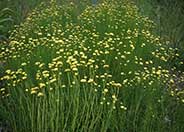
Common name:Pindo or Jelly Palm, Yatay
Botanical name:Butia capitata
This slow-growing tree has leaves that vary from bluish gray to green and has round, yellow to orange fruit that is edible and delicious. Arching leaves spread 10'-15' wide; palm can reach 20' tall.

Common name:Canary Island Date Palm
Botanical name:Phoenix canariensis
The Phoenix canariensis is a large, wide-spreading palm with a crown of many long arching fronds. It needs ample room for proper growth.

Common name:Giant Wild Rye
Botanical name:Leymus condensatus
This prominent, tall native grass does not make its way into traditional residential landscapes but can be used very effectively in a native or natural garden. It reaches heights of 6'-8' when blooming and will clump to 4'-5' wide. It requires supplemental water to remain green in the summer. Too much water will cause the grass to decline significantly. It can be pruned annually to promote new, more attractive growth. Tall grasses are highly combustible.

Common name:California Poppy, Golden Poppy
Botanical name:Eschscholzia californica
This small annual (sometimes acts as a perennial) plant will grow to less than 1' tall and has light, small blue green leaves with gold and orange flowers that bloom in spring and summer.

Common name:Yellow Cotton
Botanical name:Santolina pinnata
Yellow Cotton is a low shrub to about 2' and a little bit wider. It has dense, rich green foliage and yellow flowers. It creates a distinct Mediterranean look.

Common name:Sweet Orange cultivars
Botanical name:Citrus sinensis
This tree will grow 20'-30' high and 10'-15' wide; it produces sweet, tasty oranges. It has shiny green, leathery foliage and produces clusters of fragrant white flowers that bloom in the spring.
The Magic of Mulch
In the natural world the endless cycle of birth, growth, decay, death and rebirth flows throughout the seasons. Plants die, leaves fall and new growth springs up in its place. Nothing is lost and the fallen leaves and dead plants decay into the soil, enriching it for the next generation of growth.
Click in the green box for more information
| Designer: | Maloof 11 |
Photographer: GardenSoft |
Soils and Compost:
Incorporate compost 6" into your soil to retain water, reduce compaction, feed earthworms, and provide valuable nutrients to your plants.
Water Saving Tip:
Integrated Pest Management:
Attract, or buy beneficial insects such as ladybugs and lacewings to control pest outbreaks in your garden.

